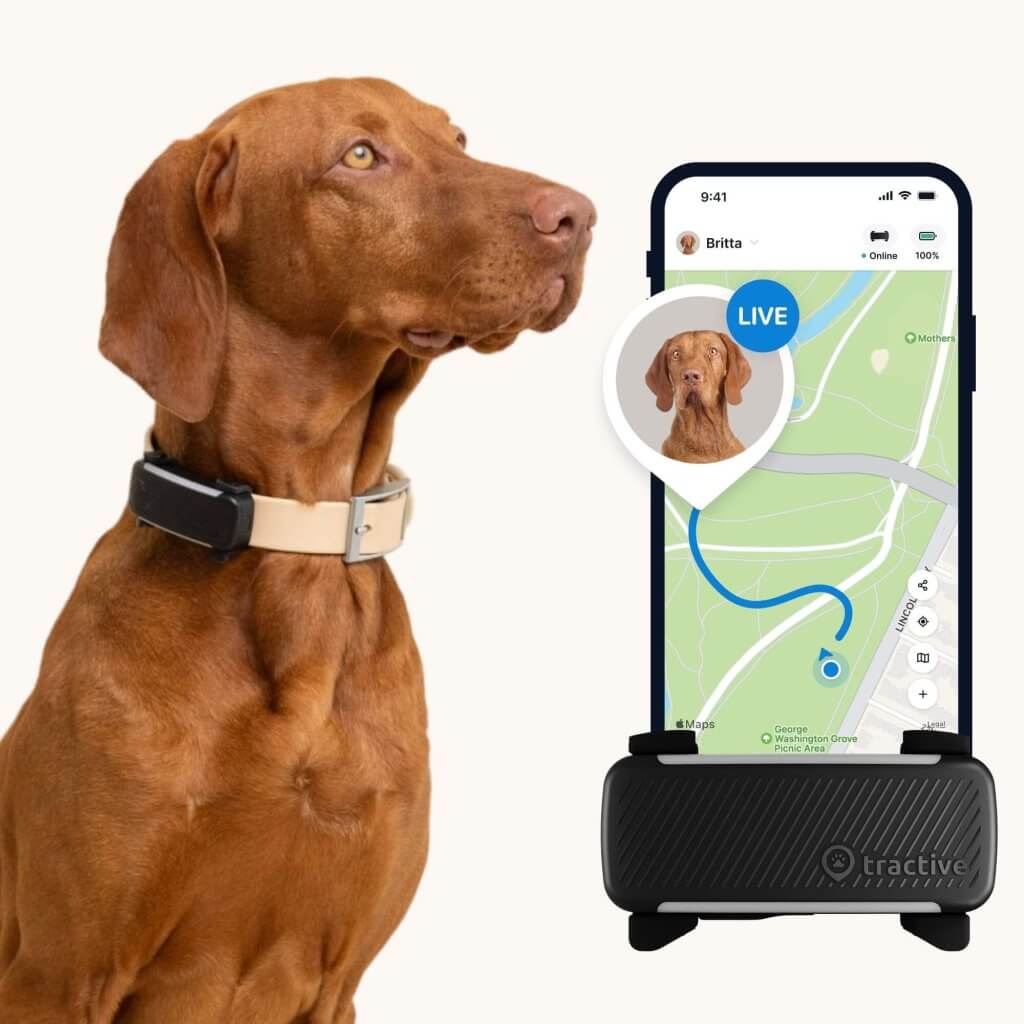Grass Awns In Dogs: A Deadly Summer Danger
Walking through a grassy field in summer with your dog may seem harmless, but there could be deadly grass awns lurking in plain sight. Learn about how this common plant affects dogs, and how to prevent your dog from coming into harm's way.
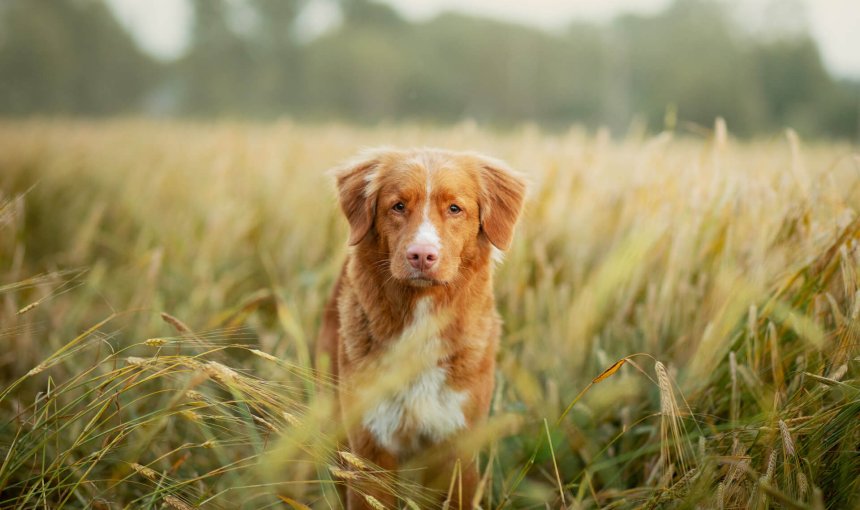
As the weather gets nicer and you two head outdoors more often – watch out: some types of grass can actually be deadly for your furry friend. In fact, grass awns in dogs can be a deadly summer danger you’re best off staying aware of. Here’s you can prep for a safe and healthy summer. (And where a smart dog tracker can be a helpful emergency measure.)

Always know your buddy is healthy & safe
Read more- What is a grass awn?
- Other names for grass awns
- How do grass awns hurt dogs?
- Which dogs are most at risk of grass awn injury?
- Grass awns in dogs: What signs to look out for
- When is it safe to remove a grass awn from my dog?
- Treatment for grass awns in dogs
- How to prevent your dog from picking up grass awns
- Where a smart dog tracker can help
- Ready for a stress-free summer outdoors?
What is a grass awn?
Grass awns are the cause of many pet emergencies in summer. These awns find their way inside a dog’s body, where they don’t belong, leading to injury, infection and illness. Grass awns are sharp, stiff, bristle-like structures which grow from the ear or flower of many types of wild grasses and grains. (Including barley and rye.1) Awns come in all different shapes and sizes – some are barbed, some are needle-like. Here’s an example of what a grass awn can look like, courtesy of veterinarian Darragh O’ Hanlon (a.k.a @thetopicalvet on Instagram).
Other names for grass awns
Due to their large variety, grass awns are called by many names, including:
- mean seeds
- foxtails
- june grass
- timothy hay
- cheatgrass
- downy brome
- needle grass
- wild barley
- spear grass
- bromegrass
How do grass awns hurt dogs?
The problem with grass awns is that they tend to get into your dog’s fur and eventually skin, causing pain and injury. Grass awns can be inhaled, swallowed and even get under a dog’s skin.
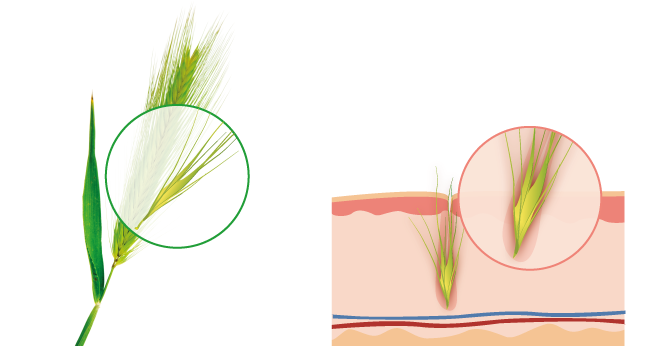
If not removed in time, grass awns can lead to infection and abscesses that need to be drained. And it’s good to act fast. Grass awns which have entered a dog’s body can migrate inside there. Eventually causing damage to internal organs such as the lungs, brain, stomach and spinal cord. This disrupts normal body functions, and can lead to sickness and even death.
Check out Barney’s story below, a real dog who was wounded and had to take a trip to the vet. All because of a few tiny grass seeds:
Which dogs are most at risk of grass awn injury?
Dogs that spend a lot of time in un-mowed, wild, green areas are most likely to suffer injury from grass awns or foxtails. That puts the following at more risk:
- sporting dogs
- field dogs
- hunting dogs
Grass awns in dogs: What signs to look out for
The symptoms of grass awns in dogs vary depending on where the awn lands on their body.
| Location | Signs of Grass Awn in Dogs |
|---|---|
| Fur / coat | – No visible infection or abscess – Matted hair |
| Inside the ear | – Scratching/rubbing the ear – Shaking the head – Holding head at a slight angle |
| In the eye | – Inflamed eye(s) – Discharge or tears |
| Nose | – Sneezing – Pawing or rubbing at the nose – Nasal discharge or drainage |
| Gums, tongue, mouth or throat | – Inflammation – Swelling |
| Between the toes | – Redness – Swelling – Draining tract – Inability to walk on the affected paw |
| Lungs or other organs (inhalation or migration) | – Tiredness – Fever – Weight loss – Shortness of breath – Vomiting – Other signs of sickness |
Be on the lookout if your dog seems to lick, scratch, rub, or chew excessively at a certain spot on their body; this could be a sign of a grass awn infection. Also look for redness, inflammation, irritation, and sores with discharge. Take note if your dog seems extra tired, depressed or has a lowered appetite. If you spot any of these symptoms, it’s best to see your vet immediately.
When is it safe to remove a grass awn from my dog?
If you notice some grass awns on your dog’s fur, remove them as soon as possible. You can remove them by hand, or use a brush to speed things up.2 It is generally safe to remove grass awns from your dog yourself, as long as the awns have not got into your dog’s body.
If you notice grass awns have punctured the skin, or are in your dog’s nose for example, it’s best not to remove them yourself but seek a vet’s assistance as soon as possible. Since awns typically have hooks or barbs at the end of them, removing them yourself could cause them to snap or break. This means that a tiny piece of the awn might remain in your dog’s body, leading to local inflammation and infection. Not to mention, it could travel deeper into the dog’s body and damage internal organs.
It’s best to see a vet immediately if you suspect a grass awn might have penetrated your dog’s skin (or any other body part).
Treatment for grass awns in dogs
Treatment for grass awns in dogs first involves identifying the injury, which is tricky because grass awns can be difficult to spot. At the vet, a thorough physical examination will help to determine the location of the grass awn. X-rays or ultrasound may also be used to locate awns. The goal of treatment is to successfully remove the grass awn and remove or heal any tissue that has been affected. This often involves surgery and antibiotic therapy, not to mention medicine against pain and inflammation.3
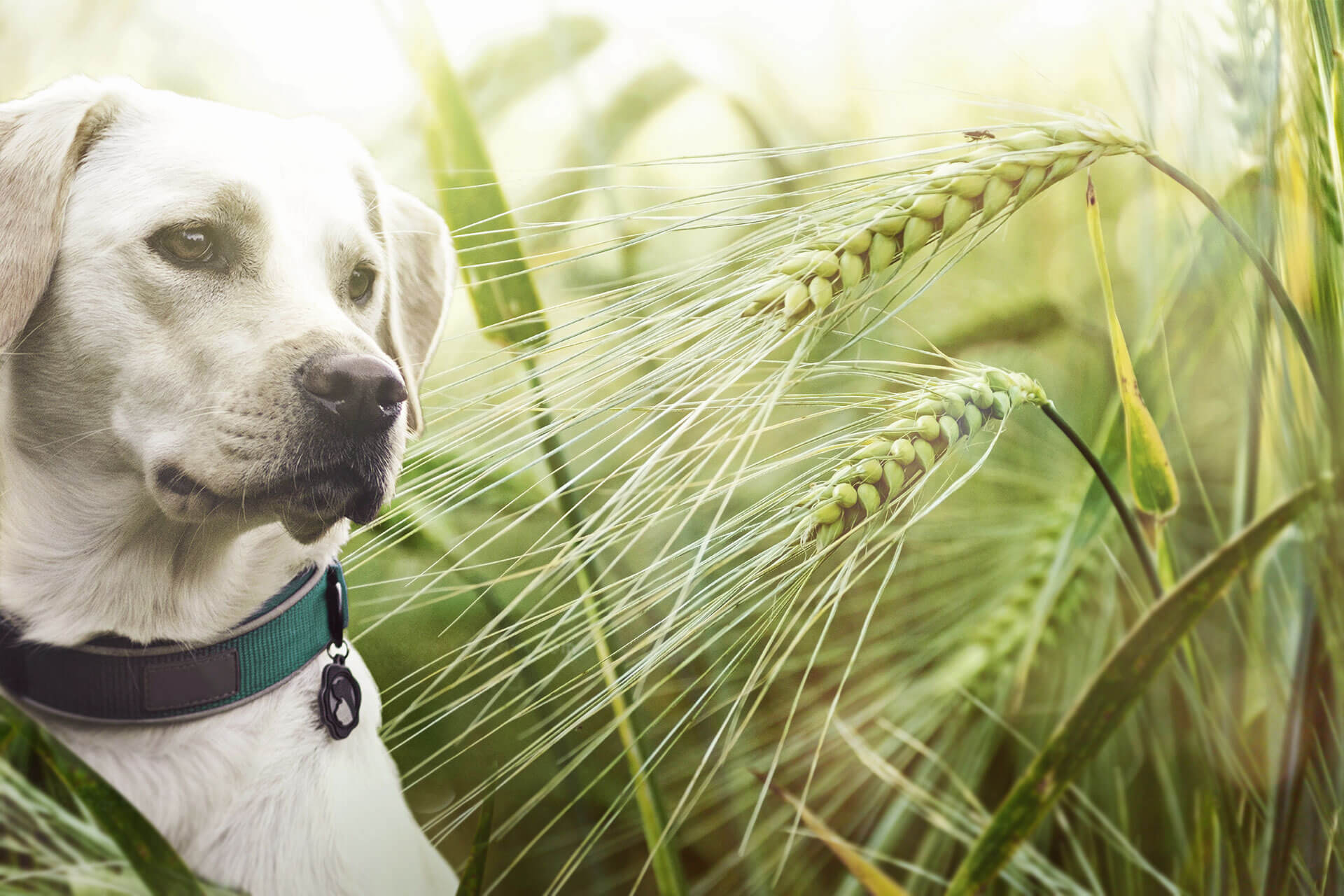
How to prevent your dog from picking up grass awns
It’s difficult to completely rule out the chances of your dog coming into contact with grass awns. But here are some precautions you can take to avoid having to go to the vet with a grass awn emergency later:
- Check your dog’s coat and feet regularly
Remove any grass seeds as soon as you find them. If your dog has a long, shaggy coat, trim their hair (if that’s an option) in summer months. Brush or comb your dog immediately after they spend time outdoors - Double check your dog’s toes, ears, and shoulders
This will help you spot grass awns quicker. Trim the fur between your dog’s toes and paw pads to make them easier to find. - Stay informed
Learn what different types of grass awns look like, and which can be found in your area. Keep potentially dangerous weeds out of your yard and avoid grassy fields and paths if you can. - Get equipped
If you do venture into grassy areas, walk your dog on a leash. Use protective gear, such as a vest, in case your dog spends a lot of time outdoors in summer
Where a smart dog tracker can help
Grass awns might seem harmless, but for dogs, they can lead to serious injuries – especially when your pup is roaming through tall grass, fields, or forest trails. That’s where a smart dog tracker like the Tractive GPS can make all the difference.
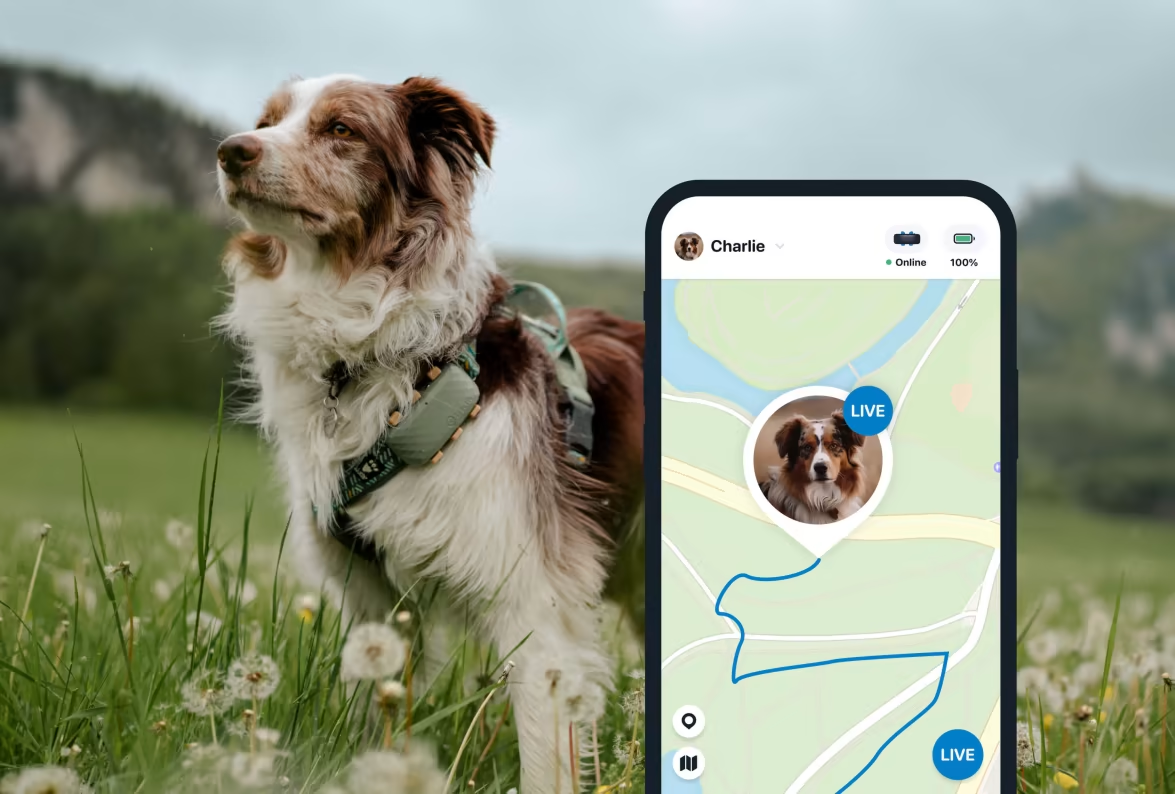
Strapped to your buddy’s collar, you can now:
- Check where your dog is – in real-time – with just a glance at your phone
If your dog wanders into risky terrain, real-time GPS tracking lets you see exactly where they are – instantly. No delays, no guesswork. Whether they’re sprinting through a grassy meadow or sneaking into an overgrown area, you’ll be able to locate them and intervene before potential danger strikes. - Mark out “no go zones” around you
Like in overgrown fields or untrimmed park edges – especially if you’ve spotted grass awns. If your dog enters a “no go zone”, you’ll get an alert to your phone right away. - Figure out where your dog spends most of their time
From their Location History, which could include any grassy fields or overgrown spots near your property. Now in an emergency – like if they get lost – you’ll know where to look first.
With features like these, Tractive offers more than just peace of mind – it empowers you to take control and keep your four-legged friend safe from hidden hazards like grass awns, wherever your adventures take you.
Ready for a stress-free summer outdoors?
Unfortunately, grass awns or grass seeds from various types of plants like barley and wheat can be a serious threat to dogs in summer. Awns are thin, sharp, spiky and barbed extensions of the flower or ear of a grass, designed to latch on to what’s nearby and spread its seeds. When the sharp ends of grass awns penetrate a dog’s body, it can lead to injury, illness, infection and – in extreme cases – death.
To keep your buddy safe:
- Remove grass awns from your dog’s fur whenever you see them.
Inspect your dogs for grass awns after they spend time outside, and keep the fur between their toes trimmed. - Head to your vet if…
The awn is in your dog’s nose, or has punctured your dog’s body. Play it safe: if you suspect your dog has come in contact with foxtails, mean seeds or any type of grass awn, your vet can help get rid of them safely. - Do not attempt to remove the awn yourself if you do see one
This could cause it to snap and leave a small bit of it in your dog. This can lead to further issues like infection and inflammation. In the worst case scenario, grass awns in dogs can travel throughout your dog’s body, causing damage to vital organs, and hurting your furry friend’s health. - You can keep your dog safe from grass seeds by…
Walking them on a leash to prevent them from running through grass, or tracking them with a GPS tracker. If they are outdoors often, a vest or other type of protective gear can come in handy.
